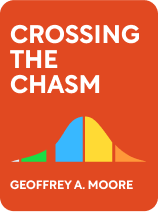

This article is an excerpt from the Shortform book guide to "Crossing the Chasm" by Geoffrey Moore. Shortform has the world's best summaries and analyses of books you should be reading.
Like this article? Sign up for a free trial here .
What is product positioning in marketing? What role does product positioning play in customers’ buying decisions?
“Positioning” refers to where potential customers place your product on the market landscape, or how they view it in relation to the competition. According to Geoffrey Moore, the author of Crossing the Chasm, positioning is the most significant factor in a customer’s decision to buy your product.
Here are five steps to position your product for success.
Product Positioning
Product positioning plays a key role in a product’s sales. The truth is many people buy products based on their reputation and market share.
Once you’ve selected your target niche market, you can begin to flesh out your marketing. Product positioning drives your marketing strategy because positioning is the most significant factor in a customer’s decision to buy your product.
Also recall that innovators and early adopters tend to position your product based on its technical qualities, while the early majority position it based on its reputation and market share.
Thus, as you enter the mainstream market, your product’s positioning will depend substantially on its reputation with key influencers and on the perceived competition.
| The Dynamic Positioning Cycle Regis McKenna echoes Moore’s assertion that positioning is the most important factor in marketing, and goes on to define a “Dynamic Positioning Cycle.” In the first stage of this cycle, you decide how to present and market your product. Then, in the second stage, the market reacts to your product and marketing campaign, and people form their opinions about your product. In the third stage, your product’s position in the market reflects on your company, establishing your company’s position. Finally, your company’s positioning affects how people view your products, completing the cycle. McKenna points out that because of the cyclical nature of dynamic positioning, problems at any stage of the cycle affect every other stage. This highlights the importance of getting the positioning cycle going in the right direction from the outset, which is the focus of Moore’s advice in this chapter. |
Step 1: Identify Your Competitors
According to Moore, early majority customers position your product mostly based on how it compares to competing alternatives. Thus, he remarks that if your product is so revolutionary that you cannot identify any clear competitors, you’re probably not ready to cross the chasm.
(Shortform note: The general premise of Blue Ocean Strategy is that finding new, un-competed markets through innovation is the key to success in business. However, if Moore is right that mainstream customers won’t register your product in a position on the market landscape until they can compare it to a competing product, then, strictly speaking, blue ocean strategy only works in the early market.)
Moore classifies competing products into two categories, both of which play important roles in your product positioning:
- A market alternative is what your target customers are currently using, the product you intend to displace.
- A product alternative is a product that is based on similar technology but used in a different application.
Moore explains that market alternatives provide something for your customers to compare your product to. If you can show them that your product is better than the alternatives, you can establish yourself as the market leader. In the case of innovative products, you can often argue that your product is better than the market alternatives because it’s based on a new technological breakthrough.
However, Moore notes that while breakthrough technology can provide a convincing argument, it can also backfire because the early majority don’t like to take chances with unproven technology. This is where the product alternative comes into play: If the same new technology is also being used in other applications, that implies that other people trust it.
| Worthy Rivals In The Infinite Game, Simon Sinek argues that you should view competing companies not as enemies, but as “worthy rivals,” because competition drives you to be better at what you do, and helps you define your own company identity more clearly by comparison. This reinforces Moore’s assertion that your customers will assess your positioning based on the competition: By highlighting differences, competition makes the unique elements of your product and company stand out, both to you and to your customers. By extension if you have no visible competition, customers may assume your product is poorly designed and overpriced, just because you have no competitors to keep you accountable. |
Step 2: State Your Positioning Claim
Moore points out that to design an effective marketing campaign, you need to know what you want to communicate. Moreover, he advises that your message should be concise enough to pass the “elevator test,” that is, to explain to a stranger during an elevator ride.
As Moore notes, a successful elevator pitch implies your message can be conveyed effectively by word of mouth. Furthermore, it’s simple enough to give customers and partner companies a clear picture of your product, so customers know what to expect and partners can see how your product would complement theirs.
Create a Product Positioning Statement
Moore advises you to make a simple and definitive positioning claim for your product. He clarifies that your claim is not a slogan for your ad campaign, but rather a reference message that you design all of your marketing communications to agree with. He suggests you develop your claim by answering the following questions, expressing your answers in two or three sentences.
- What is your product name?
- Who are your target customers?
- What is your target customer’s compelling reason to buy your product?
- What is the market alternative you are seeking to displace?
- What is the product alternative?
- How are you as a company credible and reliable?
Step 3: Substantiate Your Claim
As Moore points out, once you have stated your claim, you need to identify evidence that makes it indisputable. As we discussed in Chapter 1, each psychographic category of customer looks for a different type of evidence to position your product.
In this case, your target customer is in the early majority. Recall that the early majority places a lot of weight on reputation and market share. Moore advises that since you don’t have the largest market share yet, the evidence that you soon will is your commitment to delivering the whole product through alliances with other companies. This becomes especially convincing if your allies are among the leading vendors that your target customer already respects.
| Financial Success Is Strong Positioning Evidence Regis McKenna asserts that the strongest evidence for a positioning claim of market leadership is financial success, corroborating Moore’s assertion about market share. Like Moore, he also advises partnering with leading vendors to substantiate your positioning claim. However, building on the theme of financial success, McKenna also points out that some customers will consider the reputation of your financial backers when assessing your positioning. Thus, relationships with prominent venture capitalists can be another piece of evidence to support your positioning claim. |
Step 4: Communicate Your Claim and Evidence
Now that you’ve formulated a clear message and identified evidence to support it, you need to communicate that message to your target customers.
In discussing how to communicate your message, Moore warns against using manipulative tactics. This could involve bombarding potential customers with every possible reason they should buy your product through an overbearing ad campaign, or selectively comparing your product to alternatives that make it look good, while omitting other alternatives. However, as Moore points out, people tend to recognize these tactics for what they are.
Instead, Moore advises building mutually beneficial relationships with key influencers in your target market, so that their positive impressions will build a “word-of-mouth campaign” within your industry. He acknowledges that it takes time to identify these people and establish an ongoing dialogue with them. However, he argues that once these relationships are in place, they help to secure your position, because the early majority prefer to do business with people they know.
Communication Channels
According to Moore, you have two primary channels available to you for communicating your message, or for reaching the key influencers in your industry to get word-of-mouth started.
The first channel is the business press. Moore points out that the established business press has a strong reputation with the early majority, and they are careful to safeguard it. As such, it’s harder to get their attention as a startup, but doing so boosts your reputation significantly.
Moore’s strategy for garnering the attention of the business press relies on leveraging your whole-product partnerships. He says that when companies come together to supply an emerging market or address a market issue, the business press is often interested in covering these stories. As such, he recommends holding a press conference or sponsoring a trade conference with representatives from your partner companies, as well as customers and independent analysts all present, to initiate relationships with business press editors over your whole-product story.
The second channel is what Moore calls “vertical media,” which includes publications for the specific industry niche you are targeting, as well as conferences and trade shows where vendors can participate almost like consultants, presenting solutions to customers’ needs. Establishing a presence within the “vertical media” of your target niche allows you to connect with influencers in your industry.

———End of Preview———
Like what you just read? Read the rest of the world's best book summary and analysis of Geoffrey Moore's "Crossing the Chasm" at Shortform .
Here's what you'll find in our full Crossing the Chasm summary :
- An explanation of the chasm phenomenon that many new high-tech products face
- How to pilot a product across this chasm to mainstream success
- The problems with the Technology Adoption Life Cycle (TALC) model






